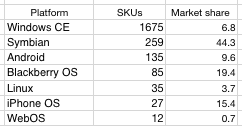Giving Android the green light:
In addition, for the time being, Microsoft will not offer new Windows versions to support non-Intel architectures that are targeting tablet PC development, noted Guggenheimer.
The formation of a market segment for a new product category necessitates the existence of a supporting ecosystem made up of a complete industry supply chain, Guggenheimer emphasized. He cited the netbook market as an example; units were selling well initially and people believed that the market was going to be established as a new segment, but recently market growth has slowed down considerably, Guggenheimer pointed out.
via Whether tablet PCs can become market segment is still uncertain, says Microsoft VP.
I remember when Microsoft used to be paranoid.


